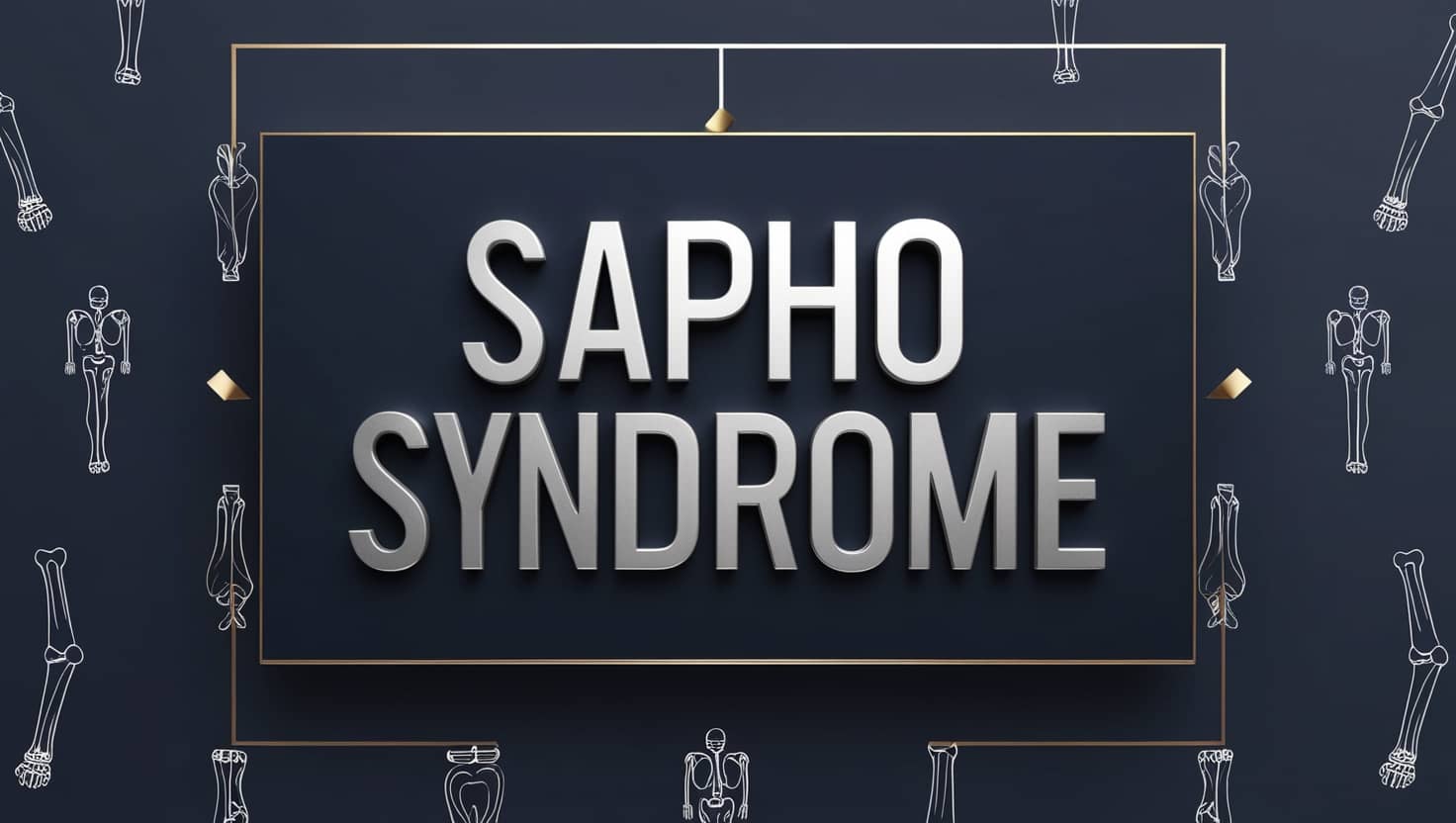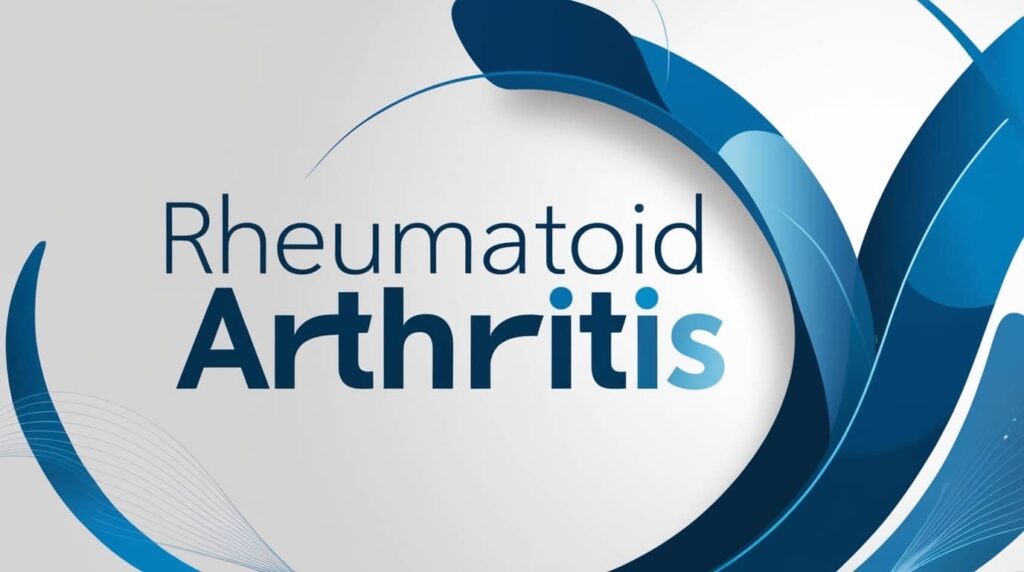SAPHO syndrome is a chronic immune-mediated condition that affects the skin, joints, and bones.
The syndrome’s abbreviation reflects the variable coexistence of synovitis, acne, pustulosis, hyperostosis, and osteitis.
The condition is rare, frequently misdiagnosed (and not recognized), and characterized by prominent inflammatory cutaneous and articular manifestations.
It most commonly affects people between the ages of 30 and 50.
Causes of SAPHO Syndrome
A variety of genetic and environmental (e.g., infectious) factors, as well as immune dysregulation, have been proposed to contribute to disease susceptibility and development.
Genetic factors → The genetic basis of SAPHO syndrome is largely unknown.
Human leukocyte antigen (HLA) associations, including HLA-A26, HLA-B27, HLA-B39, and HLA-B61, have been proposed in some studies, but none have been consistently observed.
Several genes on chromosomes 1 and 18 have been linked to conditions similar to SAPHO syndrome, including LPIN2, PSTPIP2, and NOD2, but none of them are directly pathogenic in SAPHO syndrome.
Infections → Several bacterial infections have been implicated in case reports in which organisms were isolated from bone lesions in SAPHO patients.
The most frequently reported organism among the bacteria found is Cutibacterium (previously known as Propionibacterium) acnes.
Immune dysregulation → SAPHO syndrome may be more of an autoinflammatory than an autoimmune disorder, based on findings such as impaired p53 formation, increased interleukin (IL) 10 production, and a decreased ability to mount reactive oxygen species responses.
The inflammatory response observed in SAPHO includes several pro-inflammatory cytokines such as IL-1, IL-8, IL-18, and tumor necrosis factor (TNF)-alpha.
Signs & Symptoms of SAPHO Syndrome
The SAPHO syndrome, as its name suggests, is characterized by several bone and joint findings that can cause pain, swelling, and tenderness in the affected areas.
These characteristics can be chronic, episodic, relapsing, focal, or multifocal.
Patients with osteoarticular symptoms and/or specific dermatological clinical manifestations should be suspected of having SAPHO syndrome.
Osteoarticular symptoms include: –
- Osteitis.
- Hyperostosis.
- Synovitis.
- Arthropathy.
- Symptoms of enthesopathy include fever, pain, tenderness, and sometimes swelling over the affected areas.
Osteitis is an inflammation of the bone, which can affect both the cortex and the medullary cavity.
Hyperostosis is a bone overgrowth that often appears later in the disease’s course as a result of endosteal and/or periosteal proliferation.
Sclerotic changes in the bone can occur as a result of trabecular and cortical thickening with medullary canal narrowing; concurrent osteolytic lesions may coexist when both osteitis and hyperostosis are present.
Synovitis typically manifests as non-erosive oligo-arthritis of larger joints.
Joint involvement can be due to primary arthritis or an extension of osteitis adjacent to the articular structures.
Arthritis has been found in up to 92.5% of SAPHO cases.
The axial skeleton is involved in 91% of cases, while the peripheral joints are involved in 36%.
Changes consistent with axial spondyloarthritis affecting the sacroiliac joints and spine, as well as enthesitis (inflammation and pathologic change at the site of tendinous and ligamentous insertion into bone).
Diffuse idiopathic skeletal hyperostosis (DISH), like nonmarginal enthesophytes, can occur.
Bone and joint involvement may affect a range of regions, including the anterior chest wall, other axial skeleton elements like the spine and sacroiliac joint, and medium to large lower-extremity joints.
The anterior chest wall is typically involved in 65 to 90% of patients and is thought to be highly characteristic of SAPHO syndrome; areas typically affected include: –
- Sternocostal joint.
- Sternoclavicular joints.
- Costoclavicular ligament.
There may be erythema and swelling in the soft tissue surrounding these areas.
On examination, the affected areas might be tender.
The costoclavicular ligament is involved in 48% of cases and is considered a critical early finding in SAPHO.
Mandibular involvement has been reported, particularly in young women, in the form of diffuse sclerosing sterile osteomyelitis.
The sacroiliac joint (more often), and spine are the next most commonly affected structures after the chest wall (32 to 52% of patients).
Sacroiliac involvement is typically unilateral and caused predominantly by osteitis, however, synovitis may occur secondarily.
Less than 30% of patients have peripheral joint involvement.
Upper-extremity joints are less frequently involved than hip, knee, and ankle joints.
Soft tissue swelling can be observable and cause compression of surrounding structures.
Palmoplantar pustulosis (PPP) and severe acne are common skin lesions seen in SAPHO patients.
Acne can present as orhidradenitis suppurativa, acne fulminans, or acne conglobata.
Men exhibit severe forms of acne, while women are more likely to develop PPP.
Pyoderma gangrenosum is a less common manifestation.
Read Also: Wiskott-Aldrich Syndrome | Causes, Symptoms & Treatments
Diagnosis of SAPHO Syndrome
SAPHO syndrome is diagnosed by ruling out infectious arthritis or osteomyelitis and having at least one of the four diagnostic criteria proposed by Benhamou.
As a result, the diagnosis of SAPHO syndrome is challenging in patients with a single symptomatic bone lesion, as a single skeletal lesion can be misdiagnosed as suppurative osteomyelitis, a condition with similar clinical and pathologic findings.
Benhamou Proposed Diagnostic Criteria for SAPHO Syndrome Diagnosis
- Skin manifestations of severe acne.
- Skin manifestations of palmoplantar pustulosis.
- Hyperostosis with or without dermatosis.
- Chronic recurrent multifocal osteomyelitis, with or without dermatosis, involving the axial or peripheral skeleton.
Laboratory findings generally are of little value and include mild, non-specific elevations of various inflammatory indices.
CRP and ESR are usually normal or slightly elevated during exacerbations, but white cell count is usually normal.
The HLA-B27 antigen is prevalent in adults with SAPHO syndrome, ranging between 13% and 30%.
In the SAPHO syndrome, radiologic findings may show osteolysis, osteitis, hyperostosis, and osteosclerosis.
Osteitis often shows up as osteosclerosis with a homogenous fibrillary pattern.
Hyperostosis is highly characteristic of SAPHO and is characterized by cortical thickening and chronic periosteal reaction, resulting in bone hypertrophy.
Joint erosions involving adjacent articulations are commonly seen as a result of primary arthritis or extension of adjacent osteitis.
CT and MRI are useful for locating the lesions and giving information on surrounding soft tissues, but they are unable to distinguish the difference between SAPHO lesions, osteomyelitis, and malignancy.
Bone scintigraphy is crucial in diagnosing SAPHO syndrome, especially in detecting early bone involvement.
Lesions that appear in typical locations are critical for proper diagnosis.
Bone biopsy is frequently used to make a diagnosis, especially in cases of extra-axial bone lesions, which are prone to radiologic misdiagnosis.
The histopathology of bone lesions can vary, but early lesions are characterized by the presence of polymorphonuclear infiltrate.
An intermediate phase is characterized by chronic inflammation (primarily mononuclear cells), whereas late phases are characterized by lesions with markedly enlarged and sclerotic bone trabeculae and prominent marrow fibrosis.
Propionibacterium acnes, a skin saprophyte, has been isolated from cutaneous lesions with severe acne as well as articular and osseous lesions associated with pustulosis.
However, most biopsies of involved areas show nonspecific inflammatory infiltrates and thus cannot confirm the diagnosis.
Read Also: Early Signs of Lupus in Females
Treatments for SAPHO Syndrome
SAPHO syndrome treatment remains difficult, and outcomes are known to be disappointing, particularly with the skin component of the disease.
All patients should receive treatment for osteoarticular and cutaneous manifestations of SAPHO syndrome because it is expected to reduce their risk of joint damage and other complications in addition to relieving their symptoms.
Treatment options for SAPHO include: –
- NSAIDs.
- Anti-rheumatic drugs, such as colchicine.
- Corticosteroids.
- Biphosphonates.
- Disease-modifying agents, such as methotrexate, sulfasalazine, and infliximab.
Bisphosphonates are frequently used as disease modifiers and anti-inflammatory drugs because they work by inhibiting bone resorption and turnover.
Antimicrobial therapies are a viable option because bacteria such as P acnes and Staph. Aureus has been isolated in SAPHO patient specimens and has been linked to SAPHO pathogenesis.
Injections of local corticosteroids have also been tried as local treatments.
Dermatologic treatments include topical corticosteroids, tetracycline, other antimicrobial agents, psoralen-ultraviolet A (PUVA), and retinoids.
In SAPHO, NSAIDS are typically regarded as first-line treatment, while disease-modifying medications should only be used when symptoms have persisted for at least four weeks despite adequate NSAID therapy.
Treatment with a TNF inhibitor (such as etanercept, adalimumab, or infliximab) is used for SAPHO that presents with peripheral arthritis, osteitis, or enthesitis and is not adequately controlled by MTX as well as for axial manifestations (including chest wall manifestations) in patients with an inadequate response to NSAIDs.
Surgery is only recommended when SAPHO induces changes that affect bone mechanics.
However, surgery, such as prophylactic intra-medullary nailing, is a viable option when bone destruction increases the risk of pathologic fractures.
Summary
SAPHO syndrome is a chronic immune-mediated condition that affects the skin, joints, and bones.
The syndrome’s abbreviation reflects the variable coexistence of synovitis, acne, pustulosis, hyperostosis, and osteitis.
A variety of genetic and environmental (e.g., infectious) factors, as well as immune dysregulation, have been proposed to contribute to disease susceptibility and development.
The SAPHO syndrome, as its name suggests, is characterized by several bone and joint findings that can cause pain, swelling, and tenderness in the affected areas.
Osteoarticular symptoms include: –
- Osteitis.
- Hyperostosis.
- Synovitis.
- Arthropathy.
- Symptoms of enthesopathy include fever, pain, tenderness, and sometimes swelling over the affected areas.
SAPHO syndrome is diagnosed by ruling out infectious arthritis or osteomyelitis and having at least one of the four diagnostic criteria proposed by Benhamou.
Benhamou Proposed Diagnostic Criteria for SAPHO Syndrome Diagnosis
- Skin manifestations of severe acne.
- Skin manifestations of palmoplantar pustulosis.
- Hyperostosis with or without dermatosis.
- Chronic recurrent multifocal osteomyelitis, with or without dermatosis, involving the axial or peripheral skeleton.
SAPHO syndrome treatment remains difficult, and outcomes are known to be disappointing, particularly with the skin component of the disease.
All patients should receive treatment for osteoarticular and cutaneous manifestations of SAPHO syndrome because it is expected to reduce their risk of joint damage and other complications in addition to relieving their symptoms.
Treatment options for SAPHO include: –
- NSAIDs.
- Anti-rheumatic drugs, such as colchicine.
- Corticosteroids.
- Biphosphonates.
- Disease-modifying agents, such as methotrexate, sulfasalazine, and infliximab.
References
- (PDF) Sapho Syndrome: A review – researchgate. From ResearchGate
- Sapho syndrome: Current developments and approaches to clinical treatment. From ResearchGate
- SAPHO (synovitis, acne, pustulosis, hyperostosis, osteitis) syndrome. From UpToDate
- Matzaroglou, Ch, et al. “SAPHO Syndrome Diagnosis and Treatment: Report of Five Cases and Review of the Literature.” The Open Orthopaedics Journal, vol. 3, no. 1, 5 Nov. 2009, pp. 100–106. From PubMed
- “SAPHO Syndrome – about the Disease – Genetic and Rare Diseases Information Center.” From GARD. Accessed 18 Aug. 2023.







